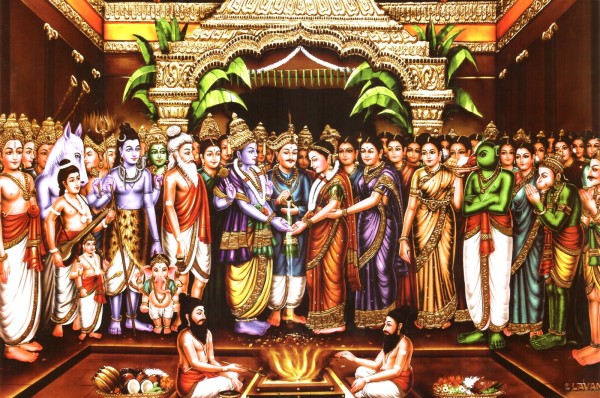Hindu Wedding – Event Of Cultural Richness
Hindu Wedding:
The Hindu Wedding ceremony is a very colourful celebration for the spectators. While performing the Hindu Marriage, many rituals are performed between the Bride and Groom. Vivaha and Kalyanam are both Sanskrit words. This Marriage is called Vivah, and the performance of Marriage is called Samskara. So Vivaha Samskara means Indian wedding. Hence the Hindu wedding follows the traditional rituals according to the Hinduism concept.
According to Indian Customs, Marriage is a vital turning event in the lives of men and women. Therefore Marriage is considered an integral part of humans. In everyone’s life, Marriage procreates children, makes society rich, ensures family duties, and serves the ancestors and God. Almost all these services get fruitful after getting the Marriage only.
Indian weddings follow customs very strictly, so the Hindu wedding ceremony extends for days, depending on the social and economic status of the bride and groom. Probably Some families spend a lot of money to organize the events. Performing the rituals during the wedding varies from region to region and cast to cast.

The Hindu people follow three varieties of Indian Wedding Traditions. They are
1. Pre-marriage rituals 2. Marriage rituals 3. post marriage rituals.
Pre-marriage rituals
Due to the Indian wedding customs, the Hindu Bride and Groom family members connected with the mediators or the relatives. On an auspicious day, they introduced each family member at the bride’s house. Both families arranged to felicitate a meeting between the bride and groom. Once they both consented, the parents proceeded with other arrangements. Then both sellers fix the marriage date, write Lagna Patrika, choose the marriage hall, and agree on the dowry and all responsibilities fulfilled before the Marriage.
Marriage Rituals
in the marriage rituals, Kanyadanam was performed by the bride’s parents. The groom ties a sacred knot called the mangal sutra. Panigrahanam means accepting the bride as his wife. Doing Saptapadi means walking seven steps together around the holy fire. The Vedic priest guides the couple to perform the rituals.
Post-wedding Rituals:
Another exciting Hindu wedding ritual is arranging traditional games between bride and groom, watching the star Arundathi, sharing a meal, and receiving blessings from elders. After all these, the Hindu bride and bridegroom start at the groom’s house. There they got the traditional welcome aarti. While stepping into the house, the Hindu bride kicks a vessel of paddy, which is kept in a pot near the Threshold. After all these Indian Wedding Traditions, the bride enters the house.
Probably the Hindu Marriage is arranged by the elders of both families. The elders on both sides play an essential role in fixing the Marriage. Even they support the newly wedded couple. Generally, in the beginning, the couple may dispute some issues due to a lack of understanding. Then the elders interfere and counsel them both and make them increase the effect among them.
Marriage is divided into eight parts according to the tradition of Hinduism.
1. Brahma Marriage:
This Marriage in Hinduism is conducted according to rituals of Vedic customs. The elders of both sides participate in the Marriage. Most Hindu marriages work in this manner.
2. Daiva Marriage:
According to the Daiva marriage, the bride’s father gives away his daughter to a priest along with ornaments as a sacrifice fee. This type of Indian wedding was performed in the ancient period only.
3. Arsha Marriage:
This Hindu Marriage is performed in exchange for a cow and bull. These Marriages are served in ascetic communities only.
4. Prajapatya Marriage:
This Marriage is celebrated with simple rituals. These marriages are performed among the present educated people. The Hindu bride and groom would exchange the garlands in the presence of friends and family members and declare themselves married.
5. Gandharva Marriage:
This is a secret marriage. Hindu Bride and groom secretly exchange the garlands. There were no Hindu wedding rituals to perform, and the elder’s presence was ignored.
6. Asura Marriage:
Asura Marriage shows the pressure of the groom’s family or other circumstances. Bride’s father agrees to the Marriage with anxiety, fear or an impression of the groom’s financial status.
7. Rakshasa Marriage:
In this Rakshasa Marriage, the groom brutally marries the Hindu bride. The involvement of violence, kidnap and even rape also causing these marriages are unacceptable.
8. Paishacha Marriage:
In this Hindu wedding, the groom throws the girl unconscious drunken and drugged, and the groom gets to marry her.
Like above the marriages, some marriages only exist in Indian Customs.